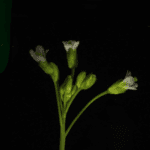It’s official, cacti are trendy. Cacti have flooded Etsy and Instagram. There are cactus-themed linens, wallpaper, shower curtains, and wedding invitations. There are cactus-shaped lamps, cellphone cases, balloons, confetti, and drink coasters.
But perhaps the scientist in you yearns to know a bit more about the biological and ecological wonders of this charming plant?
Meet the Cactaceae Family
Described as one of the most “easily recognizable, and morphologically distinct families of plants”, cacti can be found growing in arid terrains, in greenhouse conservatories, and on sunny window sills around the globe. You can even find cacti in the frigid Canadian prairies. There are species of prickly pear cactus native to Saskatchewan that can survive temperatures 40 degrees below freezing! These cacti belong to the genus Opuntia, species of which are edible. Coyotes in Colorado have a taste for Opuntia; cactus seeds can be been found in their poop. For us humans, Opuntia pads can be consumed like vegetables and the fruit consumed like, well, fruit.
Defining features of this Family of around 1600 species include sentry-like postures, spines, and vibrant flowers. The classic cactus shape—a pillar with bent arms—is reflected best by the saguaro cactus. Perching on the crown of the saguaro’s pillar is a great place to scan for prey if you’re a hawk. In the crux of the saguaro’s arms is a great place to make a nest if you’re an owl. The spines (which grow from the fuzzy holes called areoles) minimize injury to the cactus from foraging herbivores. They also collect rain and dew, hydrating the plant. The water harvesting properties of cacti spines have informed engineering of new materials. Cacti themselves are landscape engineers; they can minimize soil erosion and dust in urbanized areas of deserts. The red, orange, or neon pink flowers of cacti also grow from the areoles and flowers are the location where pollination (plant fertilization) takes place.
The birds and the bees of cacti reproduction
Flowers of cacti have been described as being “phenotypically specialized”, that is the shape, size, and colour of the flower, as well as the period of time the flower is open (or anthesis), are all tailored to the characteristics of a particular kind of pollinator.
Cacti that bloom tubular flowers with pollen hidden deep within are observed being pollinated by hummingbirds—their tubular beaks are capable of reaching into the flowers of these cacti. Cacti that bloom large pale flowers at night lure pollinators that are active at night: bats and moths. In Peru, the cactus Weberbauerocereus weberbaueri blooms overnight and is primarily pollinated by the long-snouted bat.
In the late evening on a stretch of Argentina’s High Monte desert a burst of white pops in the landscape. The cactus Echinopsis leucantha is blooming, beckoning its nocturnal pollinators, which are thought to be moths.





